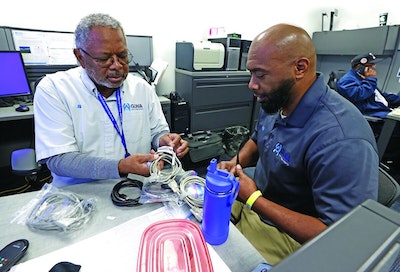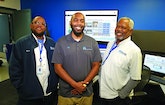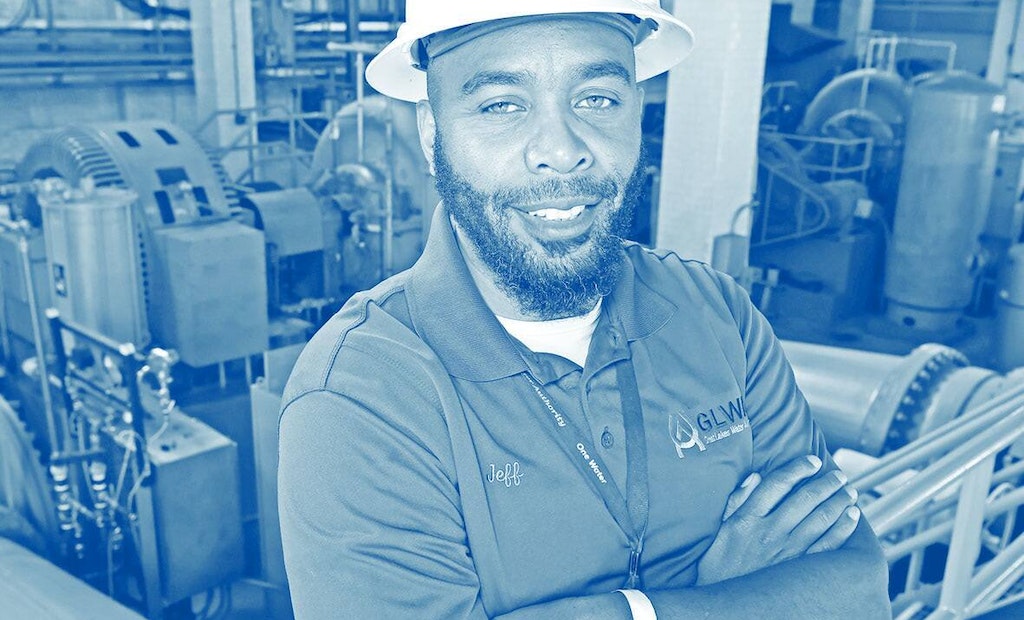Interested in Maintenance?
Get Maintenance articles, news and videos right in your inbox! Sign up now.
Maintenance + Get AlertsJeffrey Dorsey had the same level of knowledge as most people when he applied for a job in the water industry.
“I knew only that when I went to get some water, it was present,” he says. “I didn’t know anything about how water was provided. I just wanted a job.”
Today Dorsey is maintenance manager of water operations for the Great Lakes Water Authority, which operates the water and wastewater systems in and around Detroit, serving about 40% of Michigan’s population. Its five water plants have a combined capacity of 1.7 billion gallons per day.
In his role, Dorsey has led a strategic shift from reactive to planned and predictive maintenance. As a result, equipment reliability has improved dramatically, and operators draw more satisfaction from their jobs.
In 2021, Dorsey received the Operators’ Meritorious Service Award from the AWWA Michigan Section for exceptional performance in compliance with public health standards, outstanding plant maintenance, treatment improvements, operator training and dedication to the public.
Born and bred
Dorsey’s water industry journey began when he took his first job at the Detroit Water & Sewerage Department. He grew up in Detroit and attended Renaissance High School, known for its rigorous academics and college preparatory studies. In 1997 he was looking for anything when he attended a career fair and applied for that first position.
As an electrical helper, he was a low-level assistant, not even an apprentice. If a journeyman electrician needed someone to fetch a tool or hold a light, Dorsey was that guy. “I didn’t know anything about motors,” he says. “I didn’t know anything about electrical circuits.”
Being around the work helped him begin to understand electricity, and the water industry. It piqued his curiosity. After a few years as a helper, he advanced to electrical repair, learning about basic troubleshooting and installations.
In 2003 he applied for a journeyman’s position, but he ran up against a requirement of Local 58 of the International Brotherhood of Electrical Workers that said prospective journeymen had to go through the union’s apprenticeship program.
Eventually under an agreement between the union and the city, Dorsey was able to qualify by way of a written test for the union, a written test for the city, and a hands-on performance test at Henry Ford College. He received his journeyman’s card in 2003, and the electrical worker position in 2007.
Four years later, Dorsey moved up to be a professional administrative analyst and assistant to the director of water operations, a new position. His job included looking at turbidity data and other information, providing performance indicators, and producing graphs easy to understand in presentations. His boss, Terry Daniel, gave him wide latitude to define the job, so he came to understand what was happening in the operations and maintenance divisions.
Moving ahead
At the same time, Dorsey built on his practical knowledge of electrical equipment and finished a bachelor’s degree in electrical engineering at Wayne State University. In 2014 he left the city for a better-paying job with a packaging company in Cleveland.
“I was very comfortable with the water department,” he recalls. “I didn’t know anything about the packaging industry.” But he had learned not to fear challenges: “I said, ‘This may be uncomfortable, but I’m going to do it.’”
One of the key concepts he learned in the private sector was the importance of time. When equipment broke down, his maintenance team had to react quickly to put it back in service. In turn, he was challenged to think about how to do maintenance so as to minimize downtime. In 2016, the new Great Lakes Water Authority offered him the job of maintenance manager. The money was good, he had grown up in Detroit, his family was there and so he moved back.
Time management
He started the job and looked around. “The main thing I saw was a lot of responsive or reactive maintenance,” workers rushing from one breakdown to the next.
“One thing I’m a big proponent of is to make plans so things are reliable,” Dorsey says. Operators need to know they can rely on a piece of equipment whenever they want to use it. He embarked on a condition assessment of all of the remote automation, pumps and motors in the system, asking what he and his team could do in-house to increase the life of those assets.
The pumps (primarily Fairbanks) provide one example. During a year, Dorsey and his group analyzed the mean time between failures, measuring that parameter using sensors on the machines that reported actual runtime. “We began to see that if we kept equipment under 1,000 hours of runtime, we really did not see the unexpected failures,” he recalls. So the SCADA system was adjusted to flag components as they reached 1,000 hours of operation.
His team also analyzed work orders to determine what kinds of failures were happening. Small problems, such as carbon buildup on motor brushes, were handled by taking machines out of service more often for cleaning. Technicians had previously done only quarterly maintenance.
The team also used an infrared camera (Fluke) to image motors, control panels and breakers to detect abnormal heating. The information was then logged in a database so that an analyst could follow trends over time. “A lot of times you’ll see hot points around contacts, or a stator, or a motor,” Dorsey says. Based on the scans, workers know what components to watch carefully.
Changing oil in pumps and motors is also important. Workers use a small cart (Lubrication Engineers) that extracts oil, cleans it, and puts it back. The authority also hired Johnson Controls to conduct vibration analysis on equipment to monitor for premature bearing failure or pump misalignment.
Up with reliability
Each GLWA plant has both a maintenance crew leader and a planner. Planners look at all this equipment data and adjust the maintenance strategy for each site. The data also becomes part of the capital plan, so that funding requests can be justified. “Most of our plants are 30 to 60 years old, and we have a lot of old equipment,” Dorsey says.
When he took the job in 2016, the authority’s reliability percentage was about 52%. The industry standard is 80%, meaning that share of work or maintenance is planned and no more than 20% is a reaction to an unexpected failure. By 2021, the reliability percentage had increased to 94.5%.
Among the top sources of information, Dorsey says, are the people doing the work: “We have a veteran team of mechanics, electricians and first-line supervisors, and they’ve seen a lot of stuff. One thing people neglect is to listen to them. They understand some of the things we can’t understand from a higher level.” From a foundation of knowledge, work can be planned out for a week or two. Operators are more satisfied with their jobs and not frequently writing repair orders for failed equipment.
It’s teamwork
“None of this has been due to just me,” Dorsey says. “I’ve been blessed to have a really great team to work with.” That means the people who report to him: Edwin Merriweather and William Ewell, water management professionals; and Jason Hammond and Joseph Haffey, team leaders. There is also Terry Daniel, water operations director, who serves as a sounding board for ideas and sets an example by the way he handles various situations.
Since the COVID-19 pandemic began, Dorsey and his subordinates have moved to meeting online via Microsoft Teams. “It’s been a lot more effective in making sure we’re staying connected,” he says. “It’s a lot better than having to drive someplace.” At the same time, he notes, something is lost in remote meetings.
His farthest drive is to the plant in Port Huron, about an hour north of Detroit. Even with the advantages of online meetings, he makes a point of getting out to the plants, talking, listening, asking questions and reinforcing what the managers under him say.
History repeated itself with Dorsey’s current job. Just as he was the first data analyst for the Detroit Water & Sewerage Department, he was the first maintenance manager for GLWA, a position that hadn’t existed in the city department. “So it was mine to create,” he says. “They gambled on me. I rolled the dice, and we came out successful.”










